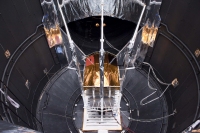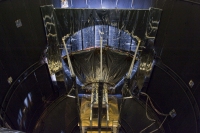Thermal testing of Gaia's Deployable Sunshield Assembly begins
22 July 2009
On 11 July the qualification model of the Gaia Deployable Sunshield Assembly (DSA) was installed inside the Large Space Simulator (LSS) at the ESTEC test facilities in Noordwijk, the Netherlands. Over the coming days the DSA will undergo a thermal vacuum and thermal balance test in simulated space conditions. The LSS is the only facility in Europe large enough to perform this test.The Gaia DSA - a unique design
| Animation 1. Deployment of the large Gaia sunshield. Credit: ESA |
Gaia will perform micro-arcsecond astrometry of 1 billion objects in our Galaxy and beyond. In order to achieve the required measurement precision the spacecraft and payload must be shielded from direct sunlight and maintained at a stable, low temperature since any thermal instability can affect the final accuracy of the measurements that will be made.
The thermal stability of the Gaia spacecraft will be largely determined by a large sunshield with a diameter of 10.2 metres when fully deployed, which Sun-facing area must remain flat within 10mm deviation over the entire spacecraft lifetime. The sunshield assembly is composed of 12 rigid rectangular panels and 12 foldable triangular sections. In order to fit inside the launcher fairing the assembly must be folded against the sides of the Gaia spacecraft. After launch the sunshield will deploy to form a large flat structure at the base of the spacecraft, supporting two parallel blankets of multi-layer insulation (MLI) which will act as thermal shields so that the solar flux is damped by a factor of 280. The large size and foldable MLI sections make this a unique sunshield design. (See also: 'Deployable sunshield' in the right-hand menu for more details on the DSA.)
Qualification model test campaign
 |
| Figure 1. The QM sunshield during a deployment test in ambient conditions inside the cleanroom at ESTEC, 3 July 2009. Credit: ESA |
The qualification model (QM) of Gaia's deployable sunshield assembly is functionally representative of the flight model and comprises 3 rigid panels (plus the 2 sections of foldable MLI between them).
The forthcoming thermal vacuum and thermal balance (TV/TB) test is part of a comprehensive qualification test campaign designed to verify the compliance of the DSA with design and operational specifications. The QM test campaign includes functional testing (deployment), vibrational testing (launch conditions), environmental testing (including the TV/TB test), and life-cycle testing (ensuring its endurance with multiple deployment tests).
Deployment tests in ambient conditions
On 29 June the QM DSA arrived at ESTEC after transport from the SENER premises in Spain. (SENER is developing the Gaia sunshield. The company is subcontractor to EADS Astrium, responsible for the overall design and development of the complete spacecraft. The frames and the blankets of the sunshield are supplied to SENER by RUAG, Switzerland.) Over the next few days the DSA was unpacked and prepared for a deployment test at ambient conditions inside the ESTEC cleanroom. The MLI blankets were attached to the DSA, and a zero-g kit - three masts with pulleys and counterweights used to simulate weightlessness - was installed. The deployment test involved the sunshield opening from its stowed configuration to its fully deployed configuration and was successfully completed on 3 July, see Figure 1.
On 11 July the QM DSA was transferred to the Large Space Simulator (LSS) for the TV/TB test. The LSS with its 9.5-metre diameter main chamber is the only facility in Europe where tests of the QM DSA can be performed in deployed configuration under simulated space conditions. The rectangular panels of the sunshield each measure about 0.8m × 3.2m and once deployed the QM DSA measures roughly 6.0m × 4.0m.
TV/TB test in the LSS
The main objective of the thermal vacuum and thermal balance (TV/TB) test is to verify:
- The deployment performance in simulated orbit conditions
- The alignment and planarity (flatness) of the DSA once it is deployed and exposed to the Sun
- The thermal performance of the sunshield
To this end several tests will be performed inside the LSS:
- Deployment test under ambient conditions, at room temperature and ambient pressure (for reference measurements)
- Deployment tests in cold vacuum
Inside the LSS chamber the environmental conditions will be regulated to simulate conditions encountered during operations in space. Shrouds with liquid nitrogen flowing through them will cool the chamber to below 100K (-173 °C). The chamber will be vacuum pumped to a pressure of less than 10-8 bar (or a hundred millionth of the normal pressure at sea level). - Verification of the planarity in cold vacuum, with and without Sun simulation
The planarity of the deployed sunshield will be tested with videogrammetry measurements. This technique uses video observations of reflectors placed at specific points on the DSA to accurately determine the relative positions of these points during the test. Deviations from the desired flat shape of the DSA in its deployed configuration can be identified this way. - Test thermal performance with Sun simulation
The thermal performance will be monitored by temperature sensors attached at a number of positions on the DSA and by temperature map measurements of the Sun-exposed surface of the deployed sunshield using an infrared camera.
During the TB/TV test the solar illumination will be simulated at different intensity levels with special lamps generating up to 1400
TB/TV test is underway
On 11 July the sunshield was lowered, in stowed configuration, into the LSS chamber using an overhead crane. In the remaining days leading up to TV/TB test the set-up and the sunshield were prepared inside the LSS chamber.
A dry run of the deployment inside the LSS was performed on 17 July under normal cleanroom conditions with the chamber still open. After bringing the sunshield back to its stowed configuration the chamber door was closed on 20 July, signalling the start of the TV/TB test in simulated space conditions. The test is scheduled to last until 27 July.
When the TV/TB test has been completed, the QM DSA will be removed from the LSS and moved back to the clean room where the life cycle deployment testing in ambient conditions will be completed before delivering the qualification model of the DSA to the Gaia prime contractor. Upon successful completion of this test campaign the manufacture of Gaia's flight model sunshield will commence, incorporating all results from the QM test campaign in the definitive design and assembly of the flight model DSA.










